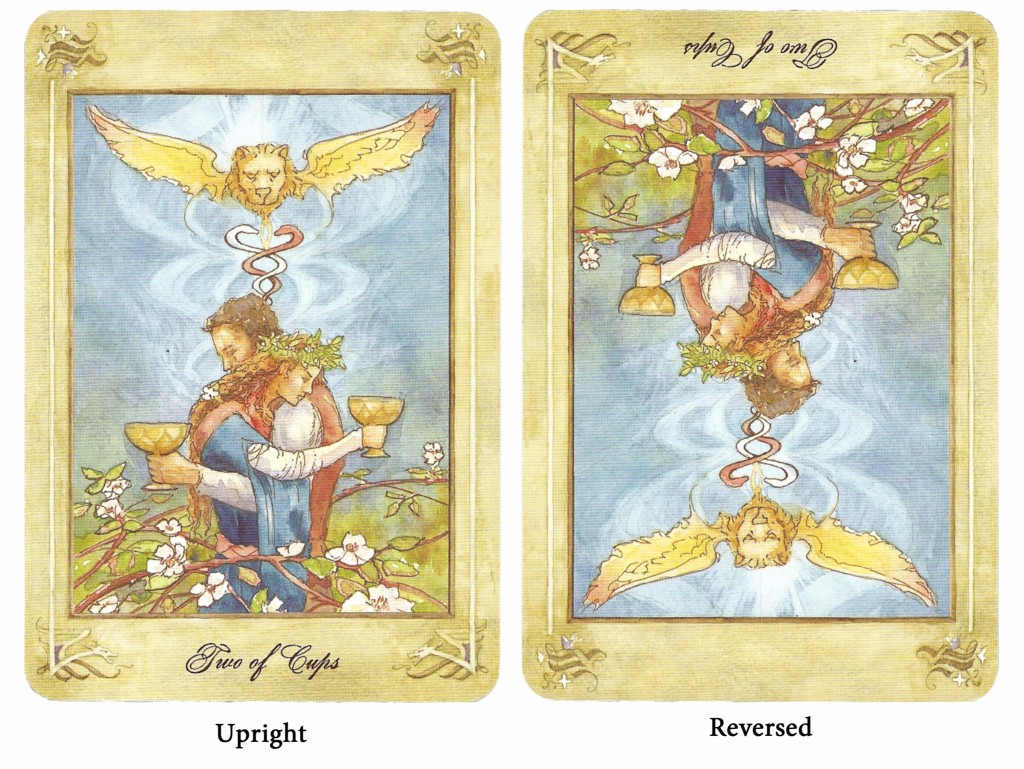What Are Tarot Reversals?
When people get to together to discuss tarot, one of the topics that often comes up is “do you read reversals?”
Reversals are cards that appear upside down relative to the orientation of the reading. Like this (The Lovers from the Llewellyn Tarot by Anna Marie Ferguson):
The topic of reversals includes several subtopics, such as do you use them (or ignore them if they show up), how to you make sure they appear in readings, and what exactly does it mean when a card is reversed?
1. Should You Use Reversals?
You need to decide for yourself. Because there are so many different ways to work with the cards, there isn’t a single rule that works for everyone.
There are two things you should do before deciding whether or not to use them. Think about the questions raised in section 3. Once you decide your philosophy, your choice will be much more clear. But even after that, the second thing you should do is try them out. Do some readings with only upright cards. Then do readings that incorporate reversed cards. If reversals enhance your reading quality, then you have your answer. If they are jarring or interrupt your visual interpretation of the cards, then perhaps they aren’t for you (unless that jarring/interrupted experience is interpreted as part of the reading!).
2. How Do Reversed Cards Come Up in a Reading?
The main way to insure that reversed cards are incorporated in your deck is to simply take a portion of the deck (I’ve heard many teachers recommend 1/3 as a good starting point), reverse them, and then shuffle them into the rest of the deck.
If you use the “finger paint” method of shuffling (lay the deck face down on the table and mix them all around, as if you were finger painting), reversed cards usually happen quite organically.
No matter how careful you are, even if you try really hard to keep all the cards upright all the time, cards are certain to get mixed up. So if you just wait long enough, they’ll happen. Some readers never, ever reorient their cards (that is, they never go through and put them all upright, never put them back in numerical order…although this is one way some readers cleanse their decks).
3. What Do Reversed Cards Mean?
Now this is the million dollar question, isn’t it? As with all things tarot, there are at least several possible answers.
Older traditions assigned specific meanings to reversed cards. Some of the meanings seemed to have nothing to do with the upright meaning. Sometimes they did. There really wasn’t any rhyme or reason to them. But many, many readers swear by these interpretations. You can decide to use a system of interpretations based on your favorite teacher, book, or deck.
Other methods include deciding on a general meaning of reversals and applying that to the upright meanings. For example, reversed cards can mean:
- the opposite of the upright meaning
- a blockage
- an inward experience (with the upright being an external experience)
- a subconscious impulse
If you decide on a general meaning to apply, go through each card and apply it to the upright meaning to make sure you have interpretations that make sense with the card and your philosophy of reversals. If you want to explore more ideas about reversals, Mary Greer’s book on the subject, The Complete Book of Tarot Reversals, is an amazing resource.
Bonus: What do you do if a card comes up reversed but you don’t read reversed cards?
1. Simply turn it rightside up and move on.
2. Decide that those cards are demanding extra attention and give them extra emphasis as you interpret the spread (turn the card upright after noting its exclamation).
3. Enjoy debating with other tarot readers about whether employing the technique described above means you are actually reading reversed cards or not.









[…] What Are Tarot Reversals? (llewellyn.com) […]
I was wondering…. I have worked with these cards for over a year now… But have had no one to ask questions to…. Are you someone that I can ask questions to about them? I do need some help. Lots I have figured out, but everything I figure out leads to more questions….
Thanks, Stefanie Lynn
i would love to get a real reading from you if its are possible. please i really do need this.
[…] Read the full article […]